South Korea ferry verdict: Sewol captain escapes death penalty
Captain Lee sentenced to 36 years in prison for abandoning ship but the victims' families say it is not enough
- Newsletter sign up Newsletter
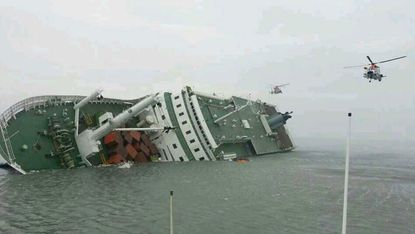
The captain of the South Korean ferry that capsized in April has escaped the death penalty and has instead been sentenced to 36 years in jail for his role in the tragedy.
Lee Joon-seok was acquitted of murder but found guilty of gross negligence for abandoning passengers onboard the overloaded Sewol ferry. More than 300 people died in what was one of South Korea’s worst maritime disasters. The vast majority of the victims were school children.
Captain Lee and several of his crew members fled the ship after it capsized and were among the first to be rescued by the coast guard. They were accused of causing hundreds of unnecessary deaths by failing to issue evacuation orders and telling the children to stay in their cabins.

Subscribe to The Week
Escape your echo chamber. Get the facts behind the news, plus analysis from multiple perspectives.

Sign up for The Week's Free Newsletters
From our morning news briefing to a weekly Good News Newsletter, get the best of The Week delivered directly to your inbox.
The court said it could not conclude that the defendants "were aware that all of the victims would die because of their actions and they had an intention to kill them," therefore, "the murder charges are not accepted," The Times reports.
Prosecutors had demanded the death penalty and before the trial even started, President Park Geun-hye made a public statement condemning the crew's action, saying that their decision to abandon ship had been "tantamount to murder".
The sentence means that Lee, aged 69, is likely to spend the rest of life in jail for his role in the tragedy, the BBC 's Steve Evans reports. The 14 crew members were found guilty of various charges, including negligence and were sentenced to between five and 20 years in prison.
The victims’ families issued a statement saying that they were "devastated" by the verdict and that justice had failed, The Guardian reports. One mother shouted: "It's not fair. What about the lives of our children? They (the defendants) deserve worse than death."
Coinciding with the verdicts, authorities have officially called off the seven-month search for the missing bodies. Divers have retrieved 295 bodies from the ocean, but nine still remain unaccounted for.
South Korea ferry: students reveal horror of Sewol disaster
Survivors of South Korea's Sewol ferry disaster have begun testifying against the captain and crew. The passenger ferry capsized on 16 April, killing 304 of the 476 people on board. More than 300 passengers were Danwon High School pupils on an organised trip, but only 75 students survived. The captain, Lee Joon-Seok, and three senior crew members are accused of "homicide through wilful negligence", a charge that can carry the death penalty, reports The Guardian . Eleven other crew are being tried on lesser violations of maritime law.
The disaster also led to South Korea's biggest manhunt, in which authorities searched for Yoo Byung-un, the owner of the ferry company. His body, which was badly decomposed, was identified a few days ago after it was discovered by a farmer in an orchard last month. Investigators say the ferry was overloaded, having been illegally modified to carry more passengers and cargo. Six students, whose names were withheld to protect their privacy, have been giving evidence. Here is what the court has heard so far:
Passengers repeatedly told to stay put
One teenager said crew members had repeatedly told passengers – "specifically the students of Danwon High School" – to stay in their cabins. Prosecutors claim it was these instructions that partly led to more deaths. Despite the ferry listing heavily, with passengers thrown to one side, an internal tannoy told passengers to put on their life vests and stay put. One student said that she and her classmates obeyed the order until the ferry had listed so far that the door to their cabin was above their heads. Her classmates clambered up fixed furniture and then pulled others up as the water rose inside the cabin, she said.
No help from crew
One witness said that at no time did any crew help her or those with whom she escaped. The bulk of the charges against the crew arise from the fact that they chose to abandon ship while hundreds of people were still trapped inside. The members of crew who stayed to help passengers were among those who died. The crew members on trial, including the captain, have said they thought it was the coastguard's job to evacuate passengers. Students say even the coastguard officers failed to come aboard to try and rescue them but simply waited outside the ferry to fish passengers out of the water.
Classmates swept away
One student described watching a wave sweep her classmates back inside the sinking boat. She said that she and a group of students managed to move along a horizontal stairwell towards an escape hatch. But as she jumped out, water swept over their escape route. "There were many classmates in the corridor and most of them were swept back into the ship," she said.
South Korea ferry: 'impossible' to determine how owner died
The death of the billionaire businessman blamed for the South Korean ferry disaster remains a mystery after foresnic experts told the BBC that the cause of death was still "unknown".
The body of fugitive Yoo Byung-eun was discovered by South Korean officials in June but was only identified last week. He went on the run soon after the Sewol ferry sank off the coast of South Korea earlier this year, killing 304 passengers, most of whom were young students.
Yoo was the owner of the ferry operator Chonghaejin Marine Co and nationwide manhunt began after police said they wanted to question him his role in the tragedy.
It was revealed that he had "hidden in a cupboard at his holiday home to evade arrest" and his body was discovered in an orchard near his cabin. The remains were discovered on 12 June, but were only identified as Yoo last week.
"It was impossible to conclude the cause of death since Yoo's body was in a very advanced stage of decomposition," said Seo Joong-seok, director of South Korea's National Forensic Service (NFS).
The tragedy in April sparked national criticism of the government and allegations of corruption among top officials.
A government investigation into the incident concluded earlier this month that the ferry sank "due to negligence and corruption", the BBC reports.
The report cited "lax regulation, poor safety inspections and a slow and badly-coordinated coast guard response" as contributing factors.
Investigators claimed that the incident had been "man-made" and was a result of top level officials "prioritising profit over safety", The Independent reports.
The report found that the disaster could have been avoided if:
- The licensing of the ship had been properly regulated. The report revealed that the vessel was licensed based on fake documents.
- Less cargo had been onboard. Officials confirmed that the Sewol had been illegally modified and was carrying almost double its legal limit.
- Adequate safety checks had been performed by the Korean Register of Shipping.
- The coastguard had responded faster and issued better rescue guidelines.
- The captain had not delayed in issuing evacuation orders.
The trial of the ferry's captain, Lee Joon-seok, and members of his crew is currently ongoing. Lee is charged with manslaughter and the other crewmembers face charges ranging from negligence to homicide.
South Korea ferry: death toll hits 100 as salvage begins
THE death toll from last week’s sinking of the South Korean ferry Sewol has passed 100 as hope runs out for those still missing. Divers will keep searching for bodies for a further two days, after which salvage experts will raise the ship.
According to the BBC , there were 476 people on the ship, of whom 339 were children and teachers taking a pre-exam school trip to Jeju island. A total of 174 passengers and crew are known to be safe, while 104 bodies have been recovered.
The families of the remaining 198 have accepted that the chances of finding anyone alive five days after the accident are “practically nil”, says The Guardian . They have agreed to allow officials to abandon the labour-intensive and dangerous search for survivors by divers in favour of raising the ship using salvage equipment.
Woo Dong-suk, an uncle of one of the missing schoolchildren told the paper: “It’s been too long already. The bodies must be decayed. The parents’ only wish right now is to find them before they are badly decomposed.”
Divers will prioritise getting into the ship’s restaurant, where they believe many of the passengers were trapped, in the last days of searching. Meanwhile, an underwater robot has been taken to the scene. It will be used to help raise the ship.
The Sewol began to list at 8.58am local time on 16 April and, within two and a half hours, had completely capsized. It is still not known what caused the disaster: there were reports that witnesses heard an impact at the time but these have not been repeated or confirmed.
The Guardian says South Korean investigators are examining evidence that an inexperienced third mate executed a dangerously sharp turn just before the ferry started listing. The captain, Lee Joon-seok, was not on the bridge at the time.
Lee, 69, and six other crew members, have been detained by the authorities. The captain has been charged with negligence and failing to secure the safety of the passengers, says Sky News .
South Korean president Park Geun-hye has publicly accused Lee of “murderous acts”, in what some observers saw as an attempt to deflect attention from an inadequate response to the disaster by the authorities.
South Korea ferry captain: ‘I bow my head in apology’
The captain of the South Korean ferry that sank this week with 475 passengers on board says he delayed issuing evacuation orders because he feared passengers would "drift away".
Lee Joon-seok, described as an industry veteran by the ship's owners and an "expert" by others, was arrested with two crew members yesterday. He has faced growing criticism for not giving orders to evacuate quickly enough.
He told television reporters: "The current was very strong, the temperature of the ocean water was cold, and I thought that if people left the ferry without proper judgement, if they were not wearing a life jacket, and even if they were, they would drift away and face many other difficulties.”
He added: "I am sorry to the people of South Korea for causing a disturbance and I bow my head in apology to the families of the victims.”
As rescue operations continue for a fourth day, the number of missing stands at 273 with 29 confirmed dead. Some 174 passengers have been rescued.
Investigators are now concentrating on the sharp turn the ship took prior to its listing and probing whether an evacuation order could have saved more lives.
The 69-year-old captain faces charges including negligence of duty and violation of maritime law. The two crew members were arrested for failing in their duty to assist passengers.
South Korea ferry passengers 'told to stay put' as ship sank
NINE people have been confirmed dead and 300 are still missing as the search operation continues in the wake of the South Korean ferry disaster, which looks likely to be one of the worst maritime disasters for decades.
Officials say that the number of casualties could rise "drastically" over the next few days, with hundreds of people believed to be trapped inside the sunken vessel.
Emergency services said last night that they had managed to save just 164 of the 470 people on board.
Survivors who were taken to the nearby island of Jindo said that crew members gave conflicting instructions as the Sewol ferry began to list violently and then sink, The Times reports.
"It was fine, then the ship went 'boom', and there was a noise of cargo falling," one passenger, Cha Eun-ok, told reporters. "The on-board announcement told people to stay put [but] people who stayed are trapped," she said.
Urgent rescue efforts are ongoing with 40 coastguard and military vessels and a team of specialist navy divers operating in the choppy waters about 20 km (12 miles) off the country's southwestern coast. But the operation has been hampered by poor weather.
Meanwhile, frustration has grown among families of the victims, as police refused to let a group of 30 civilian divers take part in the search for any survivors who may still be trapped in the sunken ferry.
The cause of the disaster was not immediately clear. The state broadcaster YTN reported that strong winds had caused cargo on top of the ship to move. The ship then began to list as passengers were instructed to put on their life jackets.
The search effort continues but many rescuers do not hold out much hope of finding any more survivors.
"Considering the water temperature, depth and the time elapsed, anyone trapped inside is unlikely to have survived," a rescue worker told local media.
Hundreds missing as South Korean ferry capsizes
TWO people are dead and almost 300 are missing after a ferry carrying 476 people capsized off the coast of South Korea.
The ferry sank between the port of Incheon, in the north-west of the country, and the southern resort island of Jeju. Among the passengers were 300 school students.
A major rescue operation is underway including dozens of coastguard and navy vessels and 18 helicopters. It was reported that 368 people had been rescued, but the BBC explains that after "a counting error" the number was halved to 180, leaving almost 300 people unaccounted for.
The two people have been confirmed dead are said to be a female crew member in her twenties, and a man who died in hospital.
The Sewol, a car and passenger ferry, sounded its distress signal shortly before 9am local time after it collided with rocks and began listing dangerously. Ferries had been cancelled overnight due to heavy fog, but locals reported that visibility had been fair by the time the Sewol set sail.
Passengers said that the ship had struck rocks 12 miles from the island of Byungpoong.
"We heard a big thumping sound and the boat stopped," one passenger told South Korean TV network YTN . "The boat is tilting and we have to hold on to something to stay seated."
One rescued student, Lim Hyung Min, told YTN that he heard a loud thump, and then the ferry began to sink. Everyone was ordered to put on their life jackets and jump overboard, he said. "I had to swim a bit to get to the boat to be rescued... The water was so cold and I wanted to live."
YTN reported that all the students have now been rescued, but the South Korean coast guard has yet to confirm those accounts.
Images shown on South Korean television showed the ship at a 45 degree angle. Later, the ship appeared to have overturned and was almost completely submerged.
Sign up for Today's Best Articles in your inbox
A free daily email with the biggest news stories of the day – and the best features from TheWeek.com

Today's Big Question It's a chance for Donald Trump to block Joe Biden's path to re-election
By Joel Mathis, The Week US Published 11 April 24

Instant Opinion Opinion, comment and editorials of the day
By Harold Maass, The Week US Published 11 April 24

Speed Read These American women reshaped the work force during World War II
By Peter Weber, The Week US Published 11 April 24

Speed Read Workers trapped in collapsed tunnel are suffering from dysentery and anxiety over their rescue
By Sorcha Bradley, The Week UK Published 22 November 23
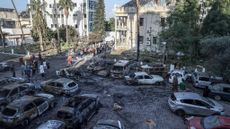
Speed Read Nobody wants to take responsibility for the deadly explosion in the courtyard of Gaza's al-Ahli Hospital. Roll the tape.
By Peter Weber, The Week US Published 19 October 23

Tall Tales And other stories from the stranger side of life
By Chas Newkey-Burden, The Week UK Published 6 October 23

By Chas Newkey-Burden, The Week UK Published 4 October 23

By Chas Newkey-Burden, The Week UK Published 3 October 23

By Chas Newkey-Burden, The Week UK Published 2 October 23

By Chas Newkey-Burden, The Week UK Published 29 September 23

It wasn't all bad Good news stories from the past seven days
By The Week Staff Published 28 September 23
- Contact Future's experts
- Terms and Conditions
- Privacy Policy
- Cookie Policy
- Advertise With Us
The Week is part of Future plc, an international media group and leading digital publisher. Visit our corporate site . © Future US, Inc. Full 7th Floor, 130 West 42nd Street, New York, NY 10036.
- Today's news
- Reviews and deals
- Climate change
- 2024 election
- Fall allergies
- Health news
- Mental health
- Sexual health
- Family health
- So mini ways
- Unapologetically
- Buying guides
Entertainment
- How to Watch
- My watchlist
- Stock market
- Biden economy
- Personal finance
- Stocks: most active
- Stocks: gainers
- Stocks: losers
- Trending tickers
- World indices
- US Treasury bonds
- Top mutual funds
- Highest open interest
- Highest implied volatility
- Currency converter
- Basic materials
- Communication services
- Consumer cyclical
- Consumer defensive
- Financial services
- Industrials
- Real estate
- Mutual funds
- Credit cards
- Credit card rates
- Balance transfer credit cards
- Business credit cards
- Cash back credit cards
- Rewards credit cards
- Travel credit cards
- Checking accounts
- Online checking accounts
- High-yield savings accounts
- Money market accounts
- Personal loans
- Student loans
- Car insurance
- Home buying
- Options pit
- Investment ideas
- Research reports
- Fantasy football
- Pro Pick 'Em
- College Pick 'Em
- Fantasy baseball
- Fantasy hockey
- Fantasy basketball
- Download the app
- Daily fantasy
- Scores and schedules
- GameChannel
- World Baseball Classic
- Premier League
- CONCACAF League
- Champions League
- Motorsports
- Horse racing
- Newsletters
New on Yahoo
- Privacy Dashboard
Vice-principal of South Korea school in ferry disaster commits suicide
By Jungmin Jang and Ju-min Park MOKPO/JINDO, South Korea (Reuters) - The vice-principal of a South Korean high school who accompanied hundreds of pupils on a ferry that capsized has committed suicide, police said on Friday, as hopes faded of finding any of the 274 missing alive. The Sewol, carrying 476 passengers and crew, capsized on Wednesday on a journey from the port of Incheon to the southern holiday island of Jeju. Kang Min-gyu, 52, had been missing since Thursday. He appeared to have hanged himself with his belt from a tree outside a gym in the port city of Jindo where relatives of the people missing on the ship, mostly children from the school, were gathered. Police said Kang did not leave a suicide note and that they had started looking for him after he was reported missing by a fellow teacher. He was rescued from the ferry after it capsized. Twenty-eight people had been officially declared dead before Kang's suicide. One hundred and seventy-four were rescued. Most of the missing are students from the Danwon High School on the outskirts of Seoul, who were on a holiday trip. The government revised the total number of passengers and the number of people rescued, saying there had been further inaccuracies in tabulation, without elaborating. Divers are fighting strong tides and murky waters to get to the sunken ship. The likelihood of finding any of the missing alive is slim. At the high school in Ansan, an industrial town near Seoul, many friends and family of the missing gathered in somber silence, with occasional sounds of sobbing breaking the quiet. "When I first received the call telling me the news, at that time I still had hope," said Cho Kyung-mi, who was waiting for news of her missing 16 year-old nephew at the school. "And now it's all gone." In the classrooms of the missing, fellow students have left messages on desks, blackboards and windows, asking for the safe return of their missing friends. "If I see you again, I'll tell you I love you, because I haven't said it to you enough," reads one message. Investigations into the sinking, South Korea's worst maritime accident in 21 years based on possible casualties, have centered on possible crew negligence, problems with cargo stowage and structural defects of the vessel, although the ship appears to have passed all of its safety and insurance checks. The ship's 69-year-old captain, was arrested early on Saturday, Yonhap news agency said, after coming under scrutiny over witness reports that he was among the first to escape the sinking vessel during its 400-km (300-mile) voyage to Jeju. According to investigators, Captain Lee Joon-seok was not on the bridge at the time the Sewol started to list sharply, with a junior officer at the wheel. Yonhap said Lee faced five charges including negligence of duty and violation of maritime law. Arrest warrants were also issued for the junior officer and one other crew member for failing in their duty to aid passengers. "I'm not sure where the captain was before the accident. However, right after the accident, I saw him rushing back into the steering house ahead of me," said Oh Young-seok, one of the helmsmen on the ship who was off duty and resting at the time. "He calmly asked by how much the ship was tilted, and tried to re-balance the ship," said Oh, who was speaking from a hospital bed in the city of Mokpo on Friday, where the injured have been taken. NORMAL PRACTICE Handing over the helm is normal practice on the voyage from Incheon to Jeju, which usually takes 13.5 hours, according to local shipping crew. Divers gained access to the cargo deck of the ferry on Friday, although that was not close to the passenger quarters, according to a coastguard official. Other coastguard officials said that divers made several attempts to reach the passenger areas but failed. "We cannot even see the ship's white color. Our people are just touching the hull with their hands," Kim Chun-il, a diver from Undine Marine Industries, told relatives of the missing. The ferry went down in calm conditions and was following a frequently traveled route in familiar waters. Although relatively close to shore, the area was free of rocks and reefs. Lee has not commented on when he left the ship, although he has apologized for the loss of life. He was described as an industry veteran by the officials from Chonghaejin Marine Co Ltd, the ship owner, and others who had met him described him as an "expert". "I don't know why he abandoned the ship like that," said Ju Hi-chun, a maritime author who interviewed the captain in 2006 as one of the experts on the route to Jeju island. But he added: "Koreans don't have the view that they have to stay with their ship until the end. It is a different culture from the West." Some media reports have said the vessel turned sharply, causing cargo to shift and the ship to list before capsizing. Marine investigators and the coastguard have said it was too early to pinpoint a cause for the accident and declined to comment on the possibility of the cargo shifting. The record of the ferry owner was also under investigation and documents were removed from its headquarters in Incheon. Chonghaejin Marine Co Ltd is an unlisted company that operates five ships. It reported an operating loss of 785 million won ($756,000) last year. According to data from South Korea's Financial Supervisory Service, a government body, Chonghaejin is "indirectly" owned by two sons of the owner of a former shipping company called Semo Marine which went bankrupt in 1997. (Additional reporting by Jack Kim, Miyoung Kim, James Pearson, Sohee Kim and Cho Meeyoung; Writing by David Chance; Editing by Raju Gopalakrishnan and Nick Macfie/Mark Heinrich)
Recommended Stories
'sasquatch sunset' is so relentlessly gross that people are walking out of screenings. star jesse eisenberg says the film was a ‘labor of love.’.
“There are so many movies made for people who like typical things. This is not that," the film's star told Yahoo Entertainment.
76ers' statue for Allen Iverson draws jokes, outrage due to misunderstanding: 'That was disrespectful'
Iverson didn't get a life-size statue. Charles Barkley and Wilt Chamberlain didn't either.
Scott Boras loses Jordan Montgomery as client after super-agent's disaster offseason
Boras reportedly demanded at least $170 million for Montgomery. The pitcher ended up getting $25 million.
Travis Kelce receives his University of Cincinnati diploma, chugs a beer on stage
Nobody is going to change the Kelce brothers.
O.J. Simpson dead at 76 after battle with cancer, family announces
O.J. Simpson, one of the most infamous figures in U.S. history, had been battling cancer.
Influencer fatigue finds its next victim: Coachella 2024
“We built a full city in the desert, and now, it’s a little too big," an event ticketing expert told Yahoo Entertainment about Coachella.
2025 Toyota 4Runner (finally!) revealed, and the new Trailhunter is extremely cool
The 2025 Toyota 4Runner is finally arriving this fall with a full lineup including returning TRD Pro and new Trailhunter. Hybrid power now available.
Republicans (?!?) are killing a tax cut
In a flip of the usual priorities, Senate Republicans seem likely to kill a set of tax cuts that have already passed the House and are broadly popular. Here's why.
2024 NBA Awards: All-NBA, All-Defensive and All-Rookie selections
Here's one voter's awards ballot with All-NBA, All-Defensive and All-Rookie selections.
2024 NBA Awards: Official picks for MVP, Rookie of the Year and every individual honor
With the 2023-24 NBA season coming to an end, here's one voter's award ballot, breaking down the top candidates — and declaring the winners.
2024 NFL Draft guide: 32 teams, 32 needs, picks, best fits and more
What selections does your team have? What areas should it address? Who's the dream fantasy pick? We cover all that and more for every franchise right here.
Adam Silver: Raptors’ Jontay Porter accused of ‘cardinal sin’ in betting scandal, full ban a possibility
The league is investigating Jontay Porter over several betting irregularities in which player props on him all hit after he left games early.
2024 WNBA Mock Draft 2.0: Caitlin Clark to Fever at No. 1, followed by Cameron Brink, Kamilla Cardoso
Where will the most hyped college stars land? How WNBA-ready are the international prospects? Who helped themselves during the NCAA tournament? And what unexpected surprises could be in store? Let’s dig in.
Shohei Ohtani scandal: The 5 most surprising revelations of Ippei Mizuhara's criminal complaint
Ippei Mizuhara allegedly stole $16 million to help pay for his gambling habit that included 19,000 illegal bets.
2024 Q1 Auto Sales: America's 3 best-selling convertibles are trucks and SUVs
The three best-selling convertibles in America are two SUVs and a truck. Where we're going, we don't need roadsters.
20 new electric cars we're excited are coming soon in 2024 and 2025
A slew of new electric cars are coming in 2024 and 2025. Here are 20 that have us looking forward to their imminent release.
2024 NFL Draft: How every team should tackle the WR position
Fantasy football analyst Matt Harmon wraps up his positional needs series with the wide receivers ahead of the NFL Draft.
Stock market today: 'Magnificent 7' power stock surge after CPI-fueled sell-off
Investors were bracing for a wholesale inflation print, after a surprise uptick in CPI shook markets and undermined bets on interest-rate cuts.
2024 NFL Draft: Favorite players outside the top 50
These aren't household names, but there are plenty of quality, if imperfect, prospects that should be available on Day 2 of the NFL Draft and beyond.
Stephen Strasburg retires after years of injury struggles and months-long standoff with Nationals
Stephen Strasburg made eight starts after signing a $245 million contract in 2019.
Make a gift to PBS NewsHour’s global reporting
and your donation will be doubled by the Dorney-Koppel Foundation!

Ariel Min Ariel Min
Leave your feedback
- Copy URL https://www.pbs.org/newshour/world/photos-parents-of-sewol-ferry-victims-in-their-childrens-rooms-untouched-since-the-disaster
Photos: Parents of South Korea ferry victims in their children’s rooms, untouched since the disaster
Lee Hye-kyung found her teenage son’s body a little more than two weeks after a South Korean ferry that was carrying him and more than 400 people sank off of the southern coast of the country. The ferry, “Sewol,” went down with more than 300 people, including 250 high school students.
“Hyeon-tak, thank you for the life you spent with me,” Lee said, standing in her son’s bedroom that remains untouched even after nearly one year since he’s been gone.
Even after a year, the traumatized country is still trying to cope with the enduring scar of the April 16, 2014, disaster. Many grieving parents and relatives of the young victims kept their kids’ rooms just as they had left it, unable to move on from the traces and memories of their beloved.
“Hyeon-tak’s body was discovered on May 1. How could I say even a word in front of such a deep sorrow? I don’t have any passion for my life. I raised him with all my heart. Hyeon-tak, thank you for the life you spent with me.” — Lee Hye-kyung, mother of Jeon Hyeon-tak

A combination picture shows Lee Hye-kyung, mother of Jeon Hyeon-tak, a high school student who died in the Sewol ferry disaster, as she poses for a photograph in her son’s room, as well as details of objects, in Ansan April 8, 2015. Photo by Kim Hong-Ji/Reuters
Prosecutors later found that the ferry had been routinely overloaded amid structure problems — it was carrying twice its legal limit of cargo at the time — and inspectors had been sloppy with regulations and there had been a long history of corruption in the shipping industry itself. As the ship sank, rescue operations were slow and unorganized; everyone was ordered to stay in their rooms, ultimately drawing a sharp criticism to the Korean government and its coast guard. Families of Sewol victims have been demanding the government to launch a more thorough investigation of the disaster and continue the search process for nine missing bodies of the victims.
“Before the accident, my family talked a lot. Now we save our words, trying not to hurt each other. I am eager to see Hwi-beom just once. I wish I could hug him.” — Shin Jum-ja, mother of Jung Hwi-beom

Shin Jum-ja, mother on the right, and Jung Soo-beom, younger brother on the left, of Jung Hwi-beom, a high school student who died in the Sewol ferry disaster, pose for a photograph in Shin’s son’s room, as well as details of objects, in Ansan April 7, 2015. Photo by Kim Hong-Ji/Reuters
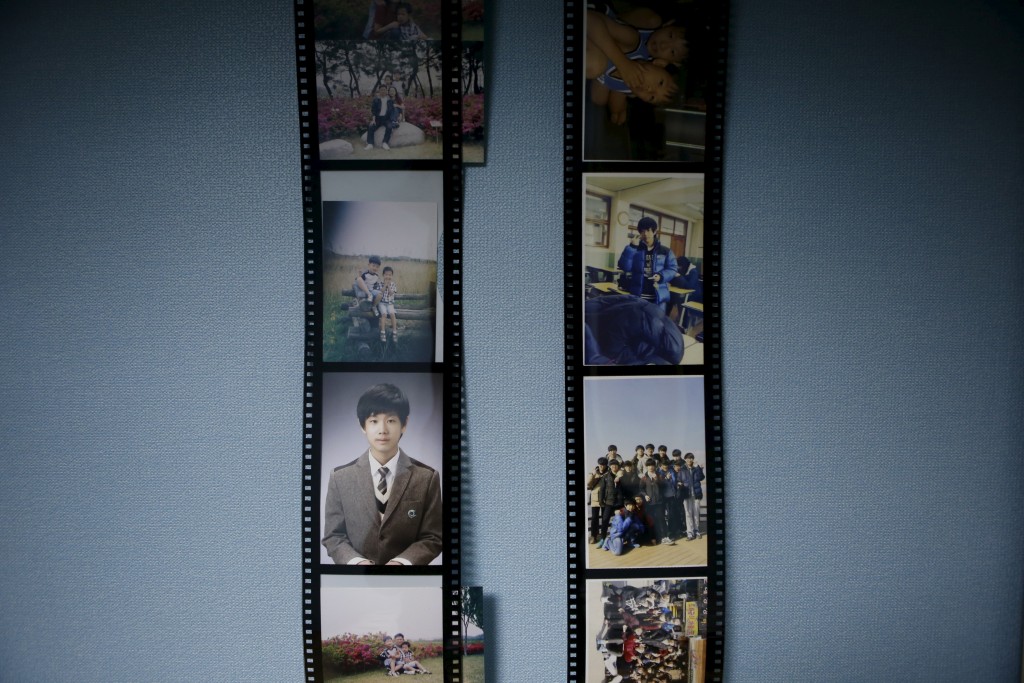
Pictures hang in the bedroom of Jung Hwi-beom. His dream was to be a car designer. Photo by Kim Hong-Ji/Reuters
“My perspective on my country has changed. I thought my country was good. I prayed for it. However, after the disaster, I could not pray for a while.” — Ahn Myeong-mi, mother of Moon Ji-sung

A combination picture shows Ahn Myeong-mi, mother of Moon Ji-sung, a high school student who died in the Sewol ferry disaster as she poses for a photograph in her daughter’s room as well as details of objects, in Ansan April 7, 2015. Photo by Kim Hong-Ji/Reuters
“I wish our country could make us feel like it is protecting us. I want to tell Ha-yeong’s younger sister about my proud country but I can’t these days. We, as adults, have a duty to protect our children.” — Kim Yu-jeong, mother of Jeon Ha-yeong
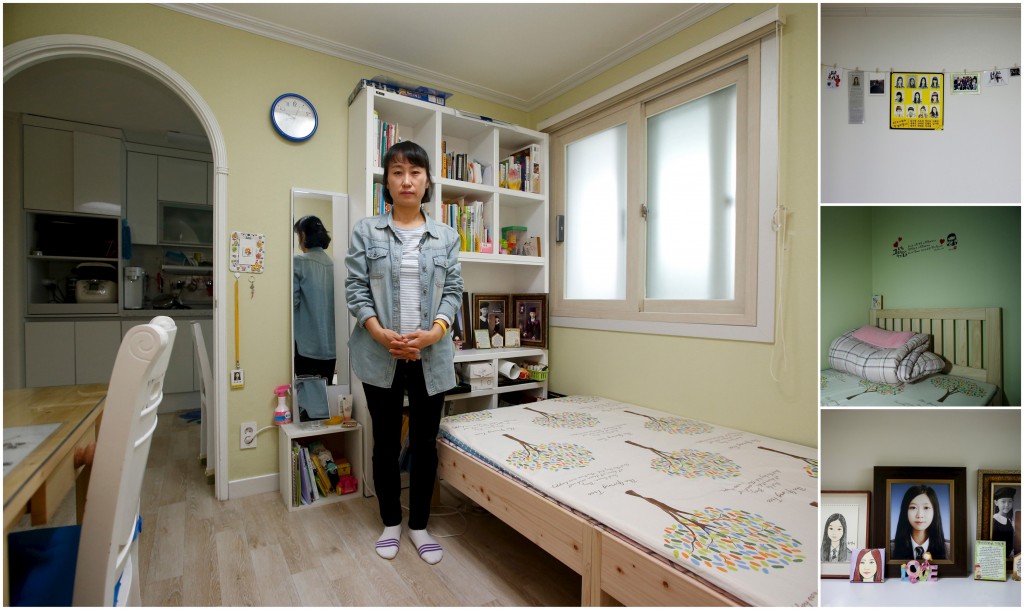
Kim Yu-jeong, mother of Jeon Ha-yeong, a high school student who died in the Sewol ferry disaster, poses for a photograph in her daughter’s room, as well as details of objects, in Ansan April 7, 2015. Kim expressed frustration with South Korea for the disaster, but she said, “I hope our children grow up well and lead our country in a right direction.” Photo by Kim Hong-Ji/Reuters
“I feel so sorry for Cha-woong and miss him so much. Those children who stayed calm in the ferry at the last moment and worried for us were better than us. I dont have confidence in my country any more. I want to move abroad, if my oldest child feels okay with it.” — Kim Youn-sil, mother of Jeong Cha-woong
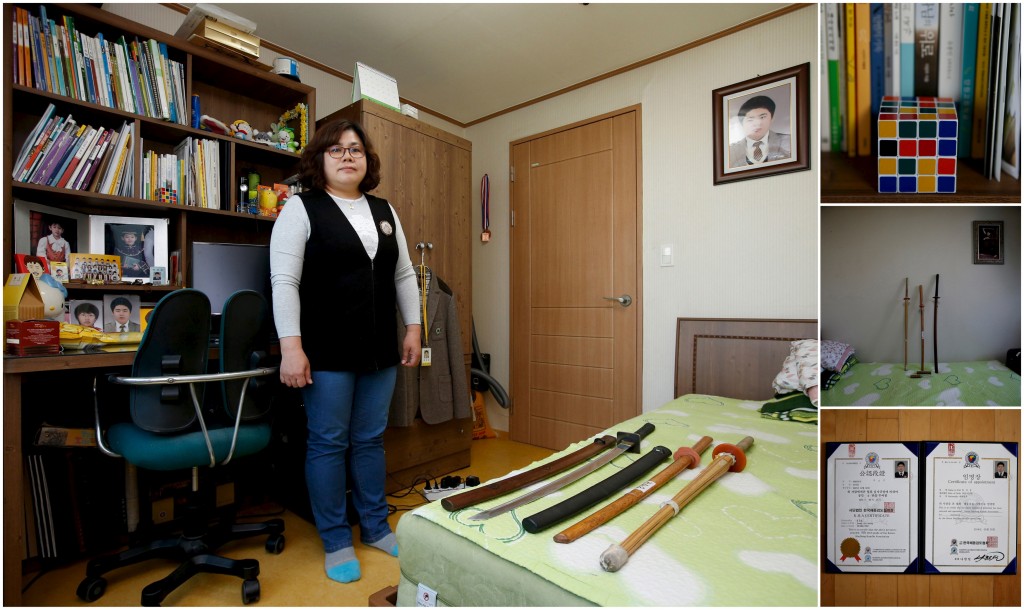
Kim Youn-sil, mother of Jeong Cha-woong, a high school student who died in the Sewol ferry disaster, poses for a photograph in her son’s room, as well as details of objects, in Ansan April 8, 2015. Photo by Kim Hong-Ji/Reuters

“Spring has come and flowers are blossoming, but moms cannot smile. I hope the children who are still missing will be found … I wish I could bring back my daughter. The world after the tragedy is not the place that I had known.” — Lee Sun-mi, mother of Kim Ju-hee

Lee Sun-mi, mother of Kim Ju-hee, a high school student who died in the Sewol ferry disaster, poses for a photograph in her daughter’s room, as well as details of objects, in Ansan April 8, 2015. Photo by Kim Hong-Ji/Reuters
“As I see the children, they are all pretty and precious. All of them have a right to be loved and have dreams. Losing these kids is a tremendous loss for our country.” — Kim Mi-hwa, mother of Bin Ha-yong
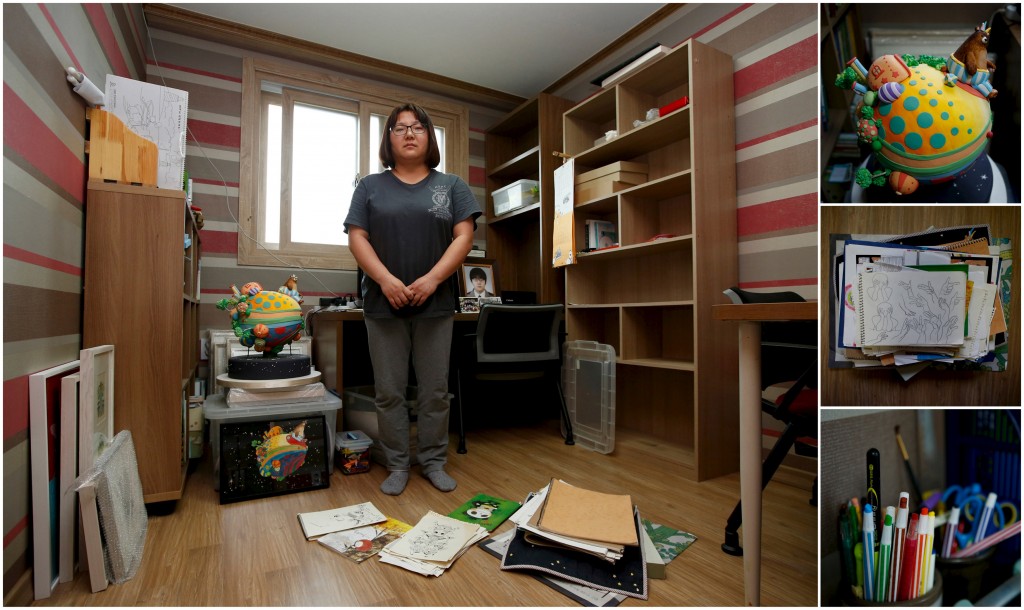
A combination picture shows Kim Mi-hwa, mother of Bin Ha-yong, a high school student who died in the Sewol ferry disaster, as she poses for a photograph in her son’s room, as well as details of objects, in Ansan April 7, 2015. Photo by Kim Hong-Ji/Reuters

Drawings are piled up in a room belonging to Bin Ha-yong, a high school student who died in the Sewol ferry disaster, in Ansan April 7, 2015. His dream was to be an illustrator. Photo by Kim Hong-Ji/Reuters
“A thorough investigation is needed, and wrongdoers should be punished. This kind of accident might happen again if we don’t know why it happened.” — Kim Young-lae, father of Kim Dong-hyuk
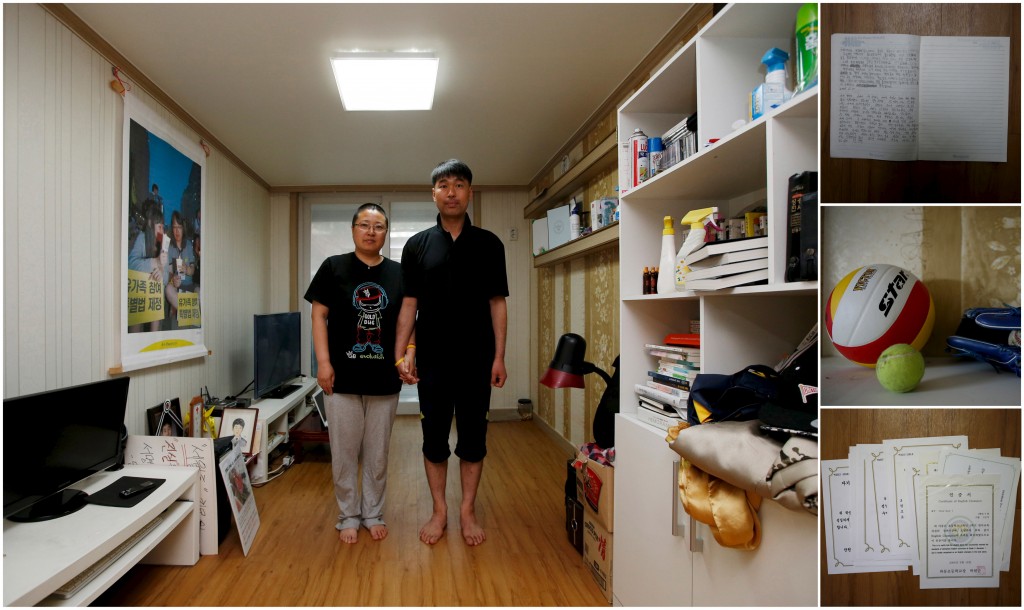
Kim Sung-sil and Kim Young-lae, parents of Kim Dong-hyuk, a high school student who died in the Sewol ferry disaster, pose for a photograph in their son’s room, as well as details of objects, in Ansan April 8, 2015. Photo by Kim Hong-Ji/Reuters
“I was protesting, asking for an inquiry to find out the real reason why the ferry capsized. Some foreign tourists took photos of me. At that moment, I felt I was an alien, although I live in this country. All I wanted to know was the reason why the crewmen were all rescued but our children had to die.” — Jung Bu-ja, mother of Shin Ho-sung

Jung Bu-ja (R) and Shin Chang-sik, parents of Shin Ho-sung, a high school student who died in the Sewol ferry disaster, pose for a photograph in their son’s room, as well as details of objects, in Ansan April 9, 2015. Photo by Kim Hong-Ji/Reuters
“Our children didn’t blame society. They tried hard to save each others lives and worried about their families. Don’t we have to learn from the efforts they showed in the last minutes of their lives?” — Jung Hye-suk, mother of Park Sung-ho

Jung Hye-suk, mother of Park Sung-ho, a high school student who died in the Sewol ferry disaster, poses for a photograph in her son’s room, as well as details of objects, in Ansan April 7, 2015. Jung said: “Good children have died because of adults’ faults. The Sewol disaster taught us about the problems of our society and adults should make efforts to fix them, although its too late. We have to strive to prevent any reoccurrence of this disaster and to build a culture that cherishes human life.” Photo by Kim Hong-Ji/Reuters
“Every relic of our children is still there. I’d like to find them … I’d also like to know the truth and the reason why they were ordered [not] to escape the ferry.” — Eom Ji-yeong, the mother of Park Ye-ji

Eom Ji-yeong, the mother of Park Ye-ji, a high school student who died in the Sewol ferry disaster, poses for a photograph in her daughter’s room, as well as details of objects, in Ansan April 8, 2015. Photo by Kim Hong-Ji/Reuters

Eom Ji-yeong poses for a photograph with a picture showing her daughter — top row, 4th to the left — with her classmates when she was 15, in her daughter’s room in Ansan April 8, 2015. Her daughter’s dream was to be a computer programmer. Photo by Kim Hong-Ji/Reuters
“I will never give up until I find her. For a year, every day was like that day, April 16, 2014. The times I laughed about trivial things have became precious moments. I thought living an ordinary life was the easiest thing, but I’ve realized it is the hardest thing.” — Park Eun-mi, mother of Huh Da-yoon

Park Eun-mi and Huh Heung-hwan, the parents of Huh Da-yoon, a high school student who died in the Sewol ferry disaster, pose for a photograph in their daughter’s room, as well as details of her belongings, in Ansan April 8, 2015. Photo by Kim Hong-Ji/Reuters
Support Provided By: Learn more
Support PBS NewsHour:

Educate your inbox
Subscribe to Here’s the Deal, our politics newsletter for analysis you won’t find anywhere else.
Thank you. Please check your inbox to confirm.

South Korean Ferry That Sank 3 Years Ago, Killing Hundreds, Lifted From Sea
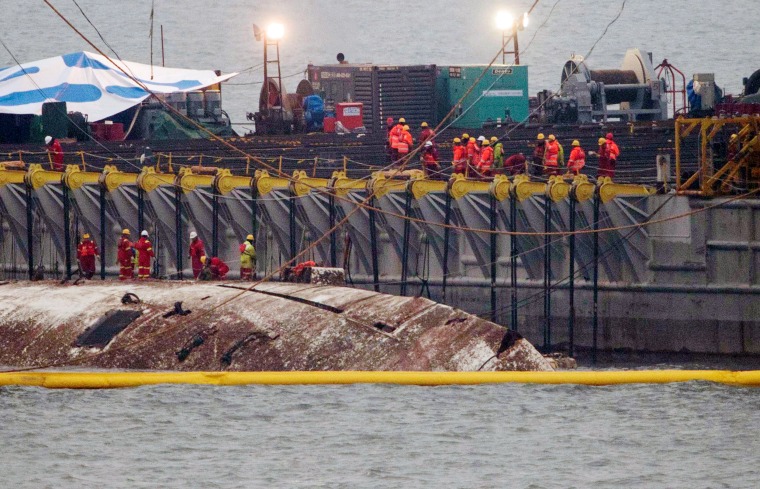
SEOUL, South Korea — A 6,800-ton South Korean ferry emerged from the water on Thursday, nearly three years after it capsized and sank into violent seas off the country's southwestern coast, an emotional moment for the country that continues to search for closure to one of its deadliest disasters ever.
More than 300 people — most of whom were students on a high school trip — died when the Sewol sank on April 16, 2014, touching off an outpouring of national grief and soul searching about long-ignored public safety and regulatory failures. The public outrage over what was seen as a botched rescue job by the government contributed to the recent ouster of Park Geun-hye as president.
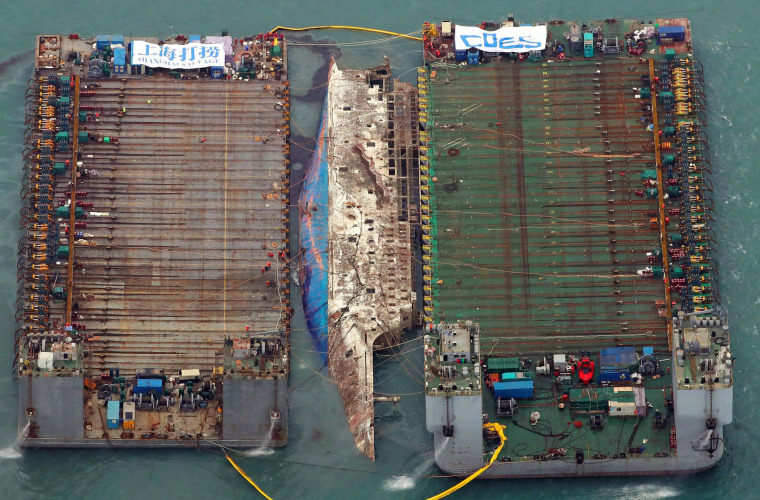
Workers on two barges began the salvaging operation Wednesday night, rolling up 66 cables connected to a frame of metal beams divers spent months putting beneath the ferry, which had been lying on its left side in about 40 meters (130 feet) of water.
By 3:45 a.m., Sewol's stabilizer surfaced from the water. About an hour later, the blue-and-white right side of ferry, rusty and scratched and its name "SEWOL" no longer visible from where it was, emerged for the first time in more than 1,000 days.
By about 7 a.m., the ferry had been raised enough for workers to climb on it and further fasten it to the barges.
Lee Cheoljo, an official from the Ministry of Oceans and Fisheries, told reporters that workers will need until late afternoon or the evening to raise the ferry until its upper side is about 13 meters (42 feet) above the surface.
Salvage crews will then load the ferry onto a semi-submersible, heavy-lift vessel that will carry it to a mainland port. The loading process, including emptying the ferry of water and fuel, is expected to take days.
The bodies of 295 passengers were recovered after the sinking on April 16, 2014, but nine are still missing . Relatives, some of whom who are watching from two fishing boats just outside the operation area, are hoping that those remains will be found inside the ferry.
"I can see it. I can see where my daughter is," Park Eun-mi, the mother of a missing 17-year-old girl, told a television crew as her boat approached the salvaging site on Wednesday. Lee Geum-hee, the mother of another missing student, said, "We just want one thing — for the ship to be pulled up so that we can take our children home."
PHOTOS: South Korean Ferry Capsizes
Once the ferry reaches a port 90 kilometers (55 miles) away in the city of Mokpo, in about two weeks, workers will begin clearing the mud and debris and search for the remains of the missing victims. An investigation committee will also be formed to search for clues that could further explain the cause of the sinking, which has been blamed on overloaded cargo, improper storage and other negligence.
The ferry's captain survived and is serving a life sentence after a court found him guilty of committing homicide through "willful negligence" because he fled the ship without issuing an evacuation order.
Park was forced to defend herself against accusations that she was out of contact for several hours on the day of the sinking. The allegations were included in an impeachment bill lawmakers passed against Park in December, amid broader corruption suspicions.
Park was formally removed from office by the Constitutional Court earlier this month. She is now under criminal investigation over suspicions that she conspired with a confidante to extort money and favors from companies and allow the friend to secretly interfere with state affairs.
South Korea in 2015 agreed to an 85.1 billion won ($76 million) deal with a consortium led by China's state-run Shanghai Salvage Co. to raise the Sewol.
The government initially planned to salvage the ferry by the end of last year, but the process was delayed due to strong currents and unfavorable weather conditions.
The Straits Times
- International
- Print Edition
- news with benefits
- SPH Rewards
- STClassifieds
- Berita Harian
- Hardwarezone
- Shin Min Daily News
- SRX Property
- Tamil Murasu
- The Business Times
- The New Paper
- Lianhe Zaobao
- Advertise with us
South Korea ferry disaster: Heartbreaking texts sent from students on vessel

SEOUL (AFP) - Heart-wrenching messages of fear, love and despair, sent by high-school students from a sinking South Korean ferry, added extra emotional weight Thursday to a tragedy that has stunned the entire nation.
Nearly 300 people - most of them students on a high school trip to a holiday island - are still missing after the ferry capsized and sank on Wednesday morning.
"Sending this in case I may not be able to say this again. Mom, I love you," one student Shin Young Jin said in a text to his mother that was widely circulated in the South Korean media.
"Oh, I love you too son," texted back his mother who was unaware at the time that her son was caught in a life-and-death struggle to escape the rapidly sinking vessel.
Unlike many others, the exchange had a happy ending as Young Jin was one of only 179 survivors rescued before the ferry capsized and went under the water.
Others were not so fortunate.
Another student, 16-year-old Kim Woong Ki sent a desperate text for help to his elder brother as the ship listed violently over to one side.
"My room is tilting about 45 degrees. My mobile is not working very well," Woong Ki messaged.
Seeking to reassure him, his brother said he was sure help was on the way.
"So don't panic and just do whatever you're told to do. Then you'll be fine," he messaged back.
There was no further communication and Woong Ki was listed among the 287 people on board still unaccounted for.
Sadly his brother's advice was similar to that of the crew who controversially ordered passengers to stay put when the ship first foundered.
Angry relatives said this resulted in the passengers getting trapped when the ferry keeled over, cutting off routes of escape.
That grim scenario was encapsulated in the texts of an 18-year-old student, identified in the local media by her surname Shin.
"Dad, don't worry. I'm wearing a life vest and am with other girls. We're inside the ship, still in the hallway," the girl messaged to her father.
Her distraught father texted her to try and get out, but it was already too late.
"Dad, I can't. The ship is too tilted. The hallway is crowded with so many people," she responded in a final message.
Some parents managed a last, traumatic phone call with their children as they tried to escape.
"She told me the ship was tilted over and she couldn't see anything," one mother recalled of a panicked conversation with her student daughter.
"She said 'I haven't put on the life jacket yet', and then the phone went dead," the mother told the Dong-A Ilbo newspaper.

Join ST's Telegram channel and get the latest breaking news delivered to you.
- Accidents - maritime
- South Korea
Read 3 articles and stand to win rewards
Spin the wheel now
Stay up to date with notifications from The Independent
Notifications can be managed in browser preferences.
UK Edition Change
- UK Politics
- News Videos
- Paris 2024 Olympics
- Rugby Union
- Sport Videos
- John Rentoul
- Mary Dejevsky
- Andrew Grice
- Sean O’Grady
- Photography
- Theatre & Dance
- Culture Videos
- Food & Drink
- Health & Families
- Royal Family
- Electric Vehicles
- Car Insurance deals
- Lifestyle Videos
- UK Hotel Reviews
- News & Advice
- Simon Calder
- Australia & New Zealand
- South America
- C. America & Caribbean
- Middle East
- Politics Explained
- News Analysis
- Today’s Edition
- Home & Garden
- Broadband deals
- Fashion & Beauty
- Travel & Outdoors
- Sports & Fitness
- Sustainable Living
- Climate Videos
- Solar Panels
- Behind The Headlines
- On The Ground
- Decomplicated
- You Ask The Questions
- Binge Watch
- Travel Smart
- Watch on your TV
- Crosswords & Puzzles
- Most Commented
- Newsletters
- Ask Me Anything
- Virtual Events
- Betting Sites
- Online Casinos
- Wine Offers
Thank you for registering
Please refresh the page or navigate to another page on the site to be automatically logged in Please refresh your browser to be logged in
South Korea ferry: Six teenage girls who survived Sewol horror describe 'floating out of cabins' as ship filled with water
Among the 75 teenagers who saw 250 of their fellow students drowned, article bookmarked.
Find your bookmarks in your Independent Premium section, under my profile

For free real time breaking news alerts sent straight to your inbox sign up to our breaking news emails
Sign up to our free breaking news emails, thanks for signing up to the breaking news email.
The first of 75 school children to speak in the trial over the South Korean ferry disaster have described how they were forced to float to safety after coastguard officers refused to help them and crew members told them to stay where they were.
Six teenage girls gave their testimony today as 15 members of the Sewol’s crew faced charges ranging from abandoning ship to manslaughter.
The horrific incident on 16 April, South Korea’s worst disaster in 44 years, saw 304 people killed. The dead included 250 teenagers from the same high school and 12 of their teachers.
Speaking today about how they witnessed the deaths of hundreds of their fellow students, the girls had their names protected and were offered the chance to speak behind a screen or via video link to minimise the trauma of going over the ordeal again.
One of the teenagers described how, even with the ship heavily listing and the water clearly flowing in, crew members had told passengers, “specifically the students of Danwon High School”, to stay in their cabins.
“We were waiting and, when the water started coming in, the class rep told everyone to put on the life vest,” another said.
“The door was above our heads, so she said we'll float and go through the door and that's how we came out. Other children who got out before us pulled us out.”
The teenagers were critical of coastguard officers, who allegedly waited on boats at a distance from the stricken ferry for passengers to swim out rather than going into the ship to try and rescue them.
“They were outside,” one said. “They pulled us [onto boats] but they didn't come inside to help. We said to ourselves: ‘Why aren't they coming in?’.”
Another student said it appeared there were more fishermen involved in the rescue than coastguard officers. Like others, she said the crew should be punished severely for their actions.
“More than that, I want to know the fundamental reason why my friends had to end up like that,” she said.
The crew members on trial, including the captain, Lee Joon-seok, have said they thought it was the coastguard's job to evacuate passengers. Video footage of their escape triggered outrage across South Korea.
South Korea ferry disaster
As well as leading to significant criticism for the government’s handling of the rescue operation, the Sewol disaster sparked South Korea’s biggest manhunt as authorities searched for Yoo Byung-un, the man at the head of a family business that operated the doomed ferry.
Yoo's badly decomposed body was identified last week after it was found by a farmer at an orchard last month.
Earlier on Monday, a close associate of Yoo, a woman identified by police only by her last name of Kim, was arrested after handing herself in. It was believed she helped him elude police after the disaster.
Another woman, the wife of Yoo's driver who was thought to have been with him during his final days at large, also turned herself in to police. And their arrests came three days after police stormed an apartment on the outskirts of Seoul and found Yoo's elder son, Dae-gyun, who was wanted for embezzlement.
Additional reporting by Reuters
Join our commenting forum
Join thought-provoking conversations, follow other Independent readers and see their replies
Subscribe to Independent Premium to bookmark this article
Want to bookmark your favourite articles and stories to read or reference later? Start your Independent Premium subscription today.
New to The Independent?
Or if you would prefer:
Want an ad-free experience?
Hi {{indy.fullName}}
- My Independent Premium
- Account details
- Help centre
Last fugitive linked to ferry disaster extradited to South Korea
- Medium Text
The Reuters Daily Briefing newsletter provides all the news you need to start your day. Sign up here.
Reporting by Jack Kim Editing by Ed Davies and Raju Gopalakrishnan
Our Standards: The Thomson Reuters Trust Principles. New Tab , opens new tab

Gunmen shot and killed nine men after abducting them from a bus in a troubled province in southwestern Pakistan bordering Afghanistan and Iran, officials said on Saturday.
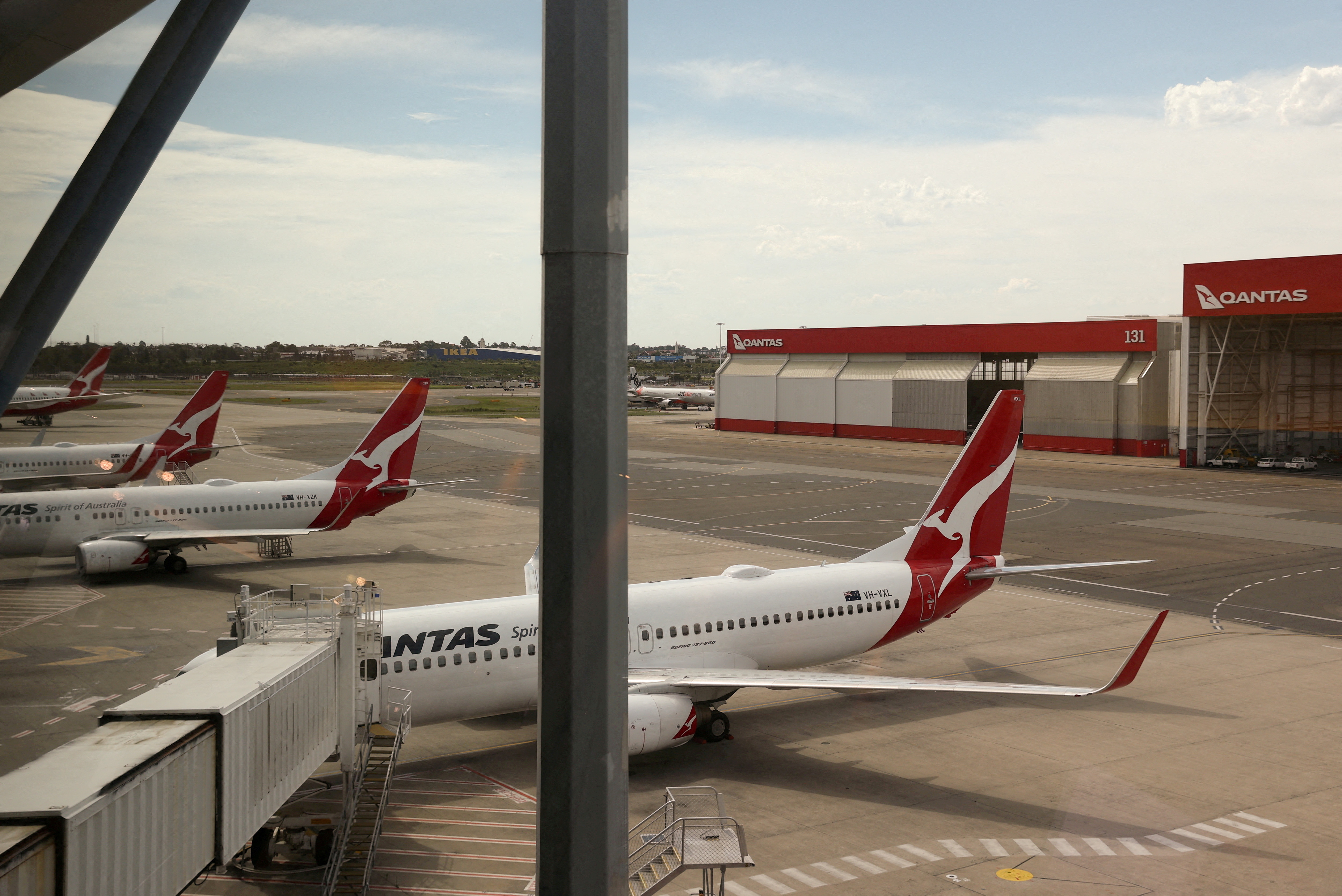
World Chevron
Spanish police said on Saturday it led an international operation to arrest a gang which allegedly defrauded 645 million euros ($686.41 million) from victims in 35 countries in a scam centred around cannabis plants for medicinal use.

A vessel has been seized by "regional authorities" between the United Arab Emirates and Iran, maritime security agencies said on Saturday, days after Iran warned it could close the area to sea traffic.

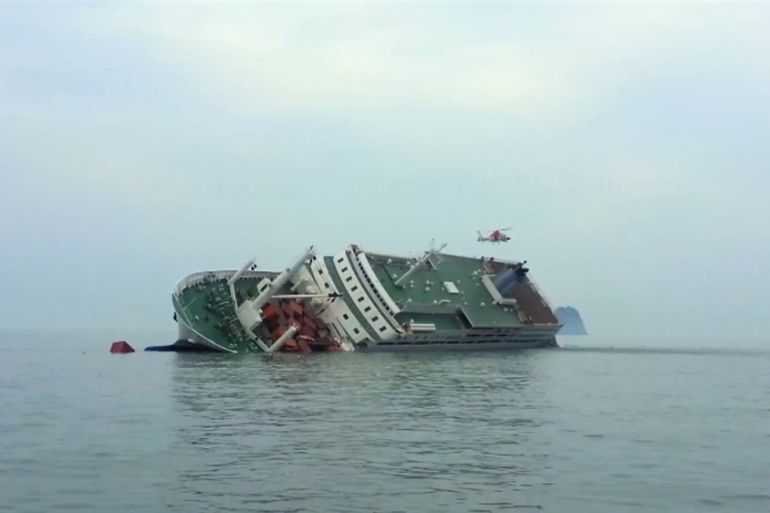
In the Absence: South Korea’s Sewol Ferry Disaster
An unflinching look at South Korea’s Sewol ferry disaster as it unfolds and its ramifications on a nation.
Editor’s note: This film is no longer available to view online.
A disaster began to quietly unfold at 8:49am on April 16, 2014.
Keep reading
In india’s richest state, exam scams kill escape from farm crisis, mexico cuts ties with ecuador after police raid embassy, peter pellegrini elected slovakia president in boost for pro-russia pm fico, portugal’s minority government takes office, faces fragmented parliament.
The Sewol ferry, bound for Jeju Island in South Korea , began to sink. On board were 476 passengers, including 325 students on a school trip. Mobile phone footage records students struggling to stay on their feet in their cabins, the atmosphere calm but uncertain.
Dashcam footage showed cars sliding across the car deck as the ship tipped.
A passenger had made an emergency call at 8:52am, a nd through radio communications the authorities were notified. The ferry continued to sink.
A single patrol boat arrived and the captain escaped the ship at 9:47am. No one had called for the passengers to evacuate.
Over the coming hours, the rescue operation never intensified – not when passengers wearing life jackets began to jump ship, not when the ferry tipped entirely on its side, and not when it sank so that only its prow remained above water.
More than 300 people, mostly school children, had lost their lives.
In the aftermath, a group of civilian divers came to assist the coastguard’s rescue efforts. For months they retrieved the bodies and belongings of victims. Public protests – and calls for justice from the victims’ families – would also help drive the removal of President Park Geun-hye in 2017.
Using phone and dashcam footage, recordings of radio communications, and the accounts of survivors, civilian rescuers, and families of the deceased, In the Absence follows the Sewol ferry disaster in meticulous detail, offering an unflinching look at one of South Korea’s great tragedies, and the layers of dysfunction and neglect that led to it.
FILMMAKER’S VIEW
By Seung-jun Yi
April 16, 2014. The day has become one of the most painful days in the modern history of Korea to most of the Korean people. They watched the sinking of MV Sewol ferry, live on TV, and 304 passengers and crew members including 250 high school students on their school trip were killed. It was painful and traumatic, not just because of the number of the victims, but because of the fact that they could have been saved.
Five years have already passed since the disaster, but I can still witness the pains of the victims’ families, civilian divers and many more people that had been affected by the tragedy.
After a long investigation, it has turned out that the tragedy was not just an unfortunate accident but was a systemic failure from the social-political frailty of Korean society.
Even though it was a clear failure of the rescue operation, no one has been punished except the captain of the coastguard boat.
History teaches us that tragedies repeat if we easily forget about them. The victims’ families ask us to “Remember 16 April”. It’s not only a call to support their demand for a proper investigation, but it is also from their wish not to witness such a tragedy again in any society.
Human beings are vulnerable to “time”. As time goes on, we forget many things. Time makes us dull. It is like a black hole that absorbs our thinking and feeling.
We need to be awakened about this world, the system and order which are controlling this world. I want people to remember the day, remember what happened on that day. And I hope people do not forget that if a system fails to operate correctly, it can result in terrible pain and trauma to innocent citizens in the end. The pain which might not be curable. This film is my plea for people to wake up and keep your eyes on the systems.
- Skip to main content
- Keyboard shortcuts for audio player
The Two-Way
International, rescue crews dive for hundreds still missing after ferry accident.
Mark Memmott
On 'Morning Edition': NPR's Anthony Kuhn reports about the ferry accident
This post is being updated as news comes in..

Unsuccessful in their attempts to find the missing in a sunken ferry off the southern coast of South Korea overnight, rescue divers resumed their search at day break Thursday, Jason Strother reports from Seoul.
A day after the boat began to sink, the cause of the accident is unclear and less than half of the passengers who were on board have been rescued, Strother tells NPR's Newscast Desk.
Most of those unaccounted for are high school students who were on a trip to a resort island.
The ship, which left the city of Incheon on South Korea's western coast Tuesday night, sent out a distress signal around 9 a.m. local time on Wednesday. That was 8 p.m. ET Tuesday. The trip south to Jeju Island was supposed to take about 14 hours. According to The Associated Press , the students and teachers are from a high school in Ansan city near Seoul.
Update at 12:15 p.m. ET, Nov. 20, 2014: The Sea of Japan is also known as the East Sea.
By the time rescuers arrived on the scene, the ferry — the Sewol — was on its side. After about two hours, according to NPR's Anthony Kuhn, the ship had turned over completely and most of it was underwater. Anthony, who is monitoring the news from Beijing, said on Morning Edition that authorities believe about 475 people were on board before the ferry went down. It was well below capacity: According to Anthony, the ship can carry as many as 900 passengers.
After midnight Thursday in Korea (late morning in the eastern U.S.), Reuters was reporting that authorities had slightly revised some of the numbers:
-- 475 people were thought to have been on board.
-- 179 were reported to have been rescued.
-- Six bodies had been recovered.
-- 290 people were still unaccounted for. (Updated figures added at 4:45 p.m. ET.)
South Korea's Yonhap News Agency reports that "fears have grown that many of those unaccounted for could be trapped inside the sunken ship and died."
Of those on board, CNN says , 325 were students and 15 were teachers from Seoul's Ansan Danwon High School. Jeju, the network adds, is "considered the Hawaii of Korea." (Update from CNN added at 9:30 a.m. ET.)
The island is a honeymoon destination and "one of the most popular vacation spots" for Koreans, Seoul-based journalist Jason Strother told All Things Considered Wednesday morning in a conversation recorded for broadcast later today .
NPR's Frank Langfitt, who is following the news from Shanghai, tells our Newscast Desk that South Korea's coast guard reports it rescued at least 164 people before the ferry sank. The water temperature in the area is just above 50 degrees Fahrenheit, Frank reports, and "South Korean authorities say people swimming in water at that temperature show signs of hypothermia after 90 minutes or two hours."
A U.S. Navy ship is heading to the site to assist South Korean rescuers.
According to Yonhap News:
"The cause of the accident was not known, though survivors said they heard a banging noise before the ship suddenly started sinking. Speculation has arisen that the ship might have hit an underwater rock or collided with another vessel. ... "The ship, which plies between Incheon and Jeju [Island] twice a week, was built in Japan in 1994, is 146 meter long and 22 meter wide, and has the maximum capacity of carrying 921 people, 180 vehicles and 152 shipping containers at the same time."
One survivor, according to Reuters , said she was on the ferry's deck when "the ship went 'boom' and there was a noise of cargo falling." Cha Eun-ok said there was an announcement that "told people to stay put." She fears that "people who stayed are trapped." (Update from Reuters added at 10:50 a.m. ET.)
According to The Wall Street Journal , "the ill-fated Sewol — its name means 'time and tide' in Korean — is 145 meters long [476 feet] and 22 meters wide [72 feet]. It can carry 921 passengers, 180 vehicles and 152 regular cargo containers at the same time. ... The 6,825-ton ferry travels twice a week between the western port of Incheon and the southern resort island of Jeju. The 264-mile trip is one of the most lucrative and common ferry lines in the country."
The Journal writes that Apostolos Papanikolaou, director of the ship design laboratory at the National Technical University of Athens, "said ships such as the Sewol are engineered to withstand flooding of two of about 15 below-deck compartments. Anything beyond that would result in the ship sinking, he said. ... This assumes all watertight doors are shut. In practice, they are often left open to allow movement of crew members between different sections of the ship. ... Mr. Papanikolaou said once water rises to the large open surfaces on the upper decks, where sometimes cars are kept, then the ship can capsize "very quickly." (Update from the Journal added at 12:15 p.m. ET.)
- accidents and disasters
- ferry disaster
- South Korea
- International edition
- Australia edition
- Europe edition
South Korea ferry disaster survivors describe chaotic scenes
Survivors of Wednesday's ferry accident off the coast of South Korea have described chaotic scenes after the vessel listed and started to sink, possibly after running aground, forcing petrified passengers to jump into the sea before it disappeared beneath the water.
As dozens of boats, helicopters and a team of South Korean navy personnel frantically tried to locate as many as 295 missing passengers before darkness set in, survivors recalled their dramatic escape bids.
Lim Hyung-min, one of a group of 325 high school pupils aboard the Sewol, told the told the YTN network that he had put on a life jacket and jumped into the sea with other pupils, before swimming to a nearby rescue boat.
"As the ferry was shaking and tilting, we all tripped and bumped into each another," Lim said from a gymnasium on a nearby island, where he and other survivors were being treated.
Lim described the sea as "so cold … I was hurrying, thinking that I wanted to live." Some of the other passengers were bleeding, he added.
Photographs from the scene showed soaked pupils, some wrapped in blankets, being treated by emergency workers on the island.
Other survivors said they feared the death toll would rise significantly as they believed dozens of people were still trapped inside the ferry after it listed and then sank into the sea about 20km (12 miles) from the coast of Byungpoong island about two hours after issuing a distress signal.
Kim Seong-mok told YTN he was certain people were trapped inside the ship as water levels quickly rose inside. The vessel's severe tilt prevented many from reaching exits from where they might have been able to leap into the sea to be picked up by rescue boats.
Some people yelled at those who couldn't get out, urging them to break windows, said Kim, who had just eaten breakfast when he felt the ferry tilt and then crash into something.
The ferry operator reportedly asked passengers to stay inside their cabins, Kim said, adding that he had not heard an announcement urging people to leave the ship before it sank.
"There was a bang and then the ship suddenly tilted over," Yonhap quoted a 57-year-old survivor as saying. "Downstairs were restaurants, shops and entertainment rooms, and those who were there are feared to have failed to escape."
The chances of surviving for long in the sea were slim. The temperature in the sea separating the South Korean mainland from a string of islands off its south-west coast was about 12C on Wednesday – cold enough to bring on symptoms of hypothermia after 90 minutes to two hours, according to a rescue worker quoted by Associated Press.
Navy divers trying to locate people still trapped inside the ship were frustrated by poor visibility created by mud stirred up from the seabed.
The pupils and their teachers, from Danwon high school in the Seoul suburb of Ansan, were travelling to Jeju island for a four-day study trip, along with about 150 other passengers, when the accident occurred.
The Sewol sent out a distress signal shortly before 9am local time. The 6,825-ton vessel had been en route from the western port of Incheon to Jeju, located about 100km (60 miles) off the mainland, when it reportedly hit rocks and began listing severely.
Pupils at the school were sent home early as distraught parents arrived seeking information about their children. Others rushed to ports in the country's south-west after receiving calls from their children confirming they were safe. One pupil said she saw several parents in tears as she left the school. Children who had not joined the trip started crying as news of the accident came through on their mobile phones, reports said.
- South Korea ferry disaster
- South Korea
- Asia Pacific
- Water transport
Most viewed
Watch CBS News
"I felt like my heart stopped"
Updated on: April 16, 2014 / 12:05 PM EDT / CBS/AP
MOKPO, South Korea -- A ferry carrying 462 people, mostly high school students on an overnight trip to a tourist island, sank off South Korea's southern coast on Wednesday, leaving more than 280 people missing despite a frantic, hours-long rescue by dozens of ships and helicopters. At least four people were confirmed dead and 55 injured.

The high number of people unaccounted for - likely trapped in the ship or floating in the ocean - raised fears that the death toll could rise drastically, making it one of South Korea's biggest ferry disasters since 1993, when 292 people died.
CBS News correspondent Seth Doane reports that a U.S. Navy ship was on standby in the area ready to aid the rescue effort.
Hundreds of parents desperately boarded buses to be taken to the area near where the ferry sank.
A mother of an 18-year-old student said, "I felt like my heart stopped. I can't describe the feeling with one word. I can't even talk about it."
One student, Lim Hyung-min, told broadcaster YTN after being rescued that he and other students jumped into the ocean wearing life jackets and then swam to a nearby rescue boat.
"As the ferry was shaking and tilting, we all tripped and bumped into each another," Lim said, adding that some people were bleeding. Once he jumped, the ocean "was so cold. ... I was hurrying, thinking that I wanted to live."
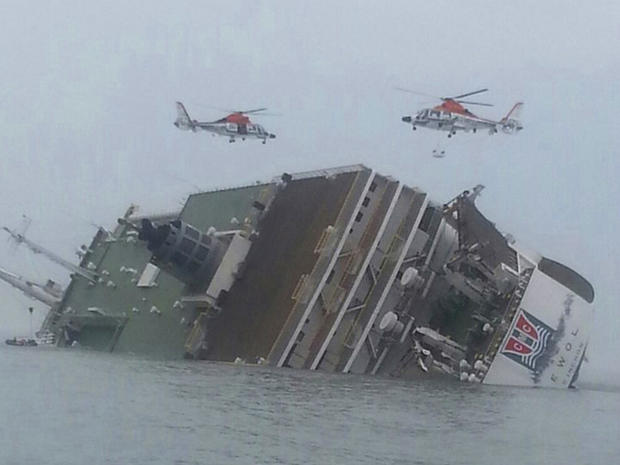
Local television stations broadcast live pictures of the ship, Sewol, listing to its side and slowly sinking as passengers jumped out or were winched up by helicopters. At least 87 vessels and 18 aircraft swarmed around the stricken ship. Rescuers clambered over its sides, pulling out passengers wearing orange life jackets. But the ship overturned completely and continued to sink slowly. Within a few hours only its blue-and-white bow stuck out of the water.

Some 160 coast guard and navy divers searched for survivors inside the ship's wreckage a few miles from Byeongpung Island, which is not far from the mainland and about 290 miles from Seoul. Cho Man-yong, a coast guard spokesman, said 16 divers approached the ferry Wednesday night but failed to get inside because the current was too strong. He said the water was very muddy and visibility was poor, but navy and coast guard divers planned to make another approach after midnight.
"We cannot give up," said South Korean President Park Geun-hye, after a briefing in Seoul with officials. "We have to do our best to rescue even one passenger."
Those rescued - wet, stunned and many without shoes - were brought to nearby Jindo Island, where medical teams wrapped them in pink blankets and checked them for injuries before settling them down on the floor of a cavernous gymnasium hall.

The ship had set off from Incheon, a city in South Korea's northwest and the site of the country's main international airport, on Tuesday night for an overnight, 14-hour journey to the tourist island of Jeju.
Three hours from its destination, the ferry sent a distress call at about 9 a.m. Wednesday after it began listing to one side, according to the Ministry of Security and Public Administration. Officials didn't know what caused it to sink and said the focus was still on rescuing survivors.
Lee Gyeong-og, a vice minister for South Korea's Public Administration and Security Ministry, said 30 crew members, 325 high school students, 15 school teachers and 89 non-student passengers were aboard the ship.
Authorities said the dead included a female crew member and two male high school students. A coast guard officer confirmed a fourth fatality but had no immediate details about it.
Kang Byung-kyu, a government minister, said 55 people were injured.
Coast guard officials said late Wednesday that they had found one more person who had been unaccounted for - a 5-year-old girl who was staying alone at a hospital after being rescued - raising the number of survivors to 175. A total of 283 people remained missing.
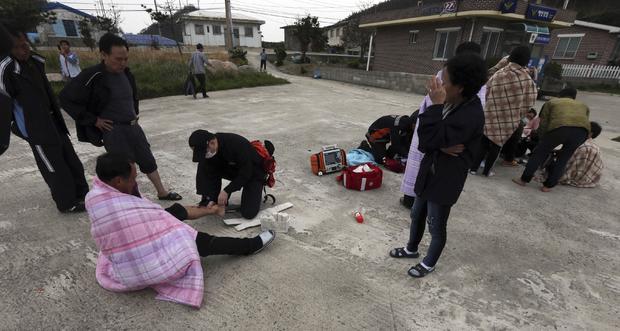
Yonhap news agency said the 480-foot-long ship, which travels twice a week between Incheon and Jeju, was built in Japan in 1994 and could carry a maximum of 921 people, 180 vehicles and 152 shipping containers.
The water temperature in the area was about 54 Fahrenheit, cold enough to cause signs of hypothermia after about 1 1/2 hours of exposure, according to an emergency official who spoke to The Associated Press on condition of anonymity citing department rules. Lee, the vice minister, said the ocean is 121 feet deep in the area.
Passenger Kim Seong-mok told YTN that he was certain that many people were trapped inside the ferry as water quickly rushed in and the severe tilt of the vessel kept them from reaching the exits. Some people urged those who couldn't get out to break windows.
Kim said that after having breakfast he felt the ferry tilt and then heard it crash into something. He said the ferry operator made an announcement asking that passengers wait and not move from their places. Kim said he didn't hear any announcement telling passengers to escape.
The students - about half of them boys and half girls- are from Danwon High School in Ansan city, which is near Seoul, and were on their way to Jeju island for a four-day trip, according to a relief team set up by Gyeonggi province, which governs the city. There are faster ways to get to Jeju, but some people take the ferry from Incheon because it is cheaper than flying. Many South Korean high schools organize trips for students in their first or second years, and Jeju is a popular destination. The students on the ferry were in their second year, which would make most of them 16 or 17.
At the high school, students were sent home and parents gathered for news about the ferry.
Park Ji-hee, a first-year student, said she saw about a dozen parents crying at the school entrance and many cars and taxis gathered at the gate as she left in the morning.
She said some students in her classroom began to cry as they saw the news on their handsets. Teachers tried to soothe them, saying that the students on the ferry would be fine.
The Maritime Ministry said the two previous deadliest ferry disasters were in 1970 when 323 people drowned and in 1993 when 292 people died.
More from CBS News
- Share full article
Advertisement
Supported by
Legacy of a South Korean Ferry Sinking

By Choe Sang-Hun
- April 11, 2015
JEJU, South Korea — At the windy port here on South Korea’s most famous resort island, stevedores prepared a ferry for its four-and-a-half-hour journey to Mokpo in the country’s southwest, chains clanking as they lashed trucks to the damp cargo deck. As truck drivers hauling cows, radishes and aluminum window frames inched their way to the front of the line, they did something they had never done before last year: They handed in paperwork certifying the weight of their cargo.
That simple safety step — an attempt to avoid dangerous overloading — is one of a host of regulatory changes made since the sinking of the Sewol ferry , one of South Korea’s most traumatic peacetime disasters. A year ago this week, the accident claimed the lives of more than 300 passengers, most of them teenagers on a school trip to Jeju.
“In the past, we didn’t weigh trucks and we didn’t know how much ships were carrying in cargo,” said Oh Myung-o, an inspector in Jeju who is back on the job while he and four other inspectors from the island stand trial for failing to stop routine overloading. “We did not suspect the Sewol would do foul play with its ballast water. We were wrong.”
As prosecutors later discovered, the Sewol was carrying twice its legal limit of cargo on its final voyage, having dumped most of the ballast water that would have helped stabilize it. The ferry operators got away with it because inspectors had limited themselves to monitoring many ships from shore; so long as vessels did not sit too low in the water, the inspectors raised no questions.
The overloading helped doom the ferry when it made a sharp turn in dangerous currents. But it was just one of numerous regulatory sins so serious that the country’s president, Park Geun-hye, vowed to untangle long-tolerated collusive ties with industry that many believe were at the heart of the tragedy.

Ferry Disaster in South Korea: A Year Later
The sinking of the ferry Sewol was among South Korea’s worst peacetime disasters and led to criminal convictions, the resignation of the country’s prime minister and the death of the billionaire who owned the ferry.
One year later, many safety experts and those working in the shipping industry say important changes have been made, including the passage of a law to ban government officials from taking expensive gifts and another to crack down on business owners whose companies are involved in major disasters.
The second law was passed after prosecutors alleged that members of the flamboyant family they say owned the Sewol had illegally siphoned funds from the ferry company, forcing its managers to overload ferries and scrimp on safety measures .
But government critics remain bitter, convinced Ms. Park’s administration is more interested in moving past the tragedy that has threatened to become her biggest legacy than in undertaking a serious investigation of the disaster and bungled rescue. They cite recent safety lapses on ships as evidence of continued wrongdoing.
Last weekend, thousands of people, including 70 of the Sewol victims’ parents who shaved their heads in protest, marched in downtown Seoul to demand that a new investigation be opened.
In what some saw as an effort to halt the criticism, Ms. Park — whose approval ratings have never recovered after the sinking — announced on Monday that her government would consider the costly task of raising the Sewol. The bodies of nine passengers — four of them high school students — have never been found.
“For one year, we have been praying and begging to them to help find our loved ones,” said Lee Keum-hui, the mother of a teenager whose body is still missing. “But nothing has changed for us.”
Many of the grieving parents believe the government has tried to refocus anger on the family who prosecutors say owned the Sewol. (The patriarch died while on the run under circumstances that have yet to be fully explained.)
South Korea has long been known for its high tolerance of corruption in service of stoking its economy. Collusive ties between regulators and businesses have been blamed for building collapses, as well as rising fears about the country’s nuclear power industry.
In an attempt to address such corruption in the shipping industry, the government revised laws in recent months to stipulate harsher financial penalties and longer prison terms for ferry crews and companies that violate safety rules.
Dozens of regulators, crew members, ship inspectors and officials with ferry and loading companies have been convicted or face trial for their roles in the Sewol disaster.
“After the Sewol, I was ashamed to tell people that I worked on a ferry,” said Kim Young-jin, the captain of the Hanil Blue Narae, a car ferry that sails between Jeju and Wando, another island off the country’s southern coast. “We now pay more attention to safety.”
Last month, the government announced a $27 billion safety plan that called for hiring more rescuers and safety supervisors, deploying bigger rescue ships and helicopters, and financing more training for ferry crews. (The first coast guard rescue boats arriving at the Sewol disaster had inadequate equipment and did little more than watch the ship slowly disappear beneath the waves as passengers trapped inside called for help through the windows.)
But Park Jun-do, of the civic group People’s Solidarity for Social Progress, said the government’s safety measures were little more than “window-dressing” and fell far short of addressing deeply rooted corruption that is still undermining safety.
Nearly eight months after the Sewol disaster, a South Korean trawler sank off eastern Russia in stormy weather, with 53 sailors presumed dead. The police later discovered that the ship’s captain was not on board, though its log said he was, and the sailor in charge was not qualified for the job.
In January, three months after the government required all trucks to weigh themselves at government-licensed measuring stations, JTBC, a local cable channel, discovered that some drivers loaded extra cargo after leaving the stations. As a result, the government is now conducting random inspections.
And in an attempt to eradicate dangerous conflicts of interest, the government has said it would transfer pier-side inspectors like Mr. Oh from the Korea Shipping Association, which is financed by shipping companies, to a government-funded agency.
But just last month, government auditors revealed that two officials from that agency had approved the illegal remodeling of two ships. (One of the many problems found with the Sewol, according to prosecutors, was that regulators allowed the ferry owners to add passenger berths to improve earnings, changes that made the ship top-heavy and vulnerable to tilting.)
Kim Chul-soo, the captain of the 15,000-ton Sea Star Cruise ferry recently docked at Jeju, cited a similar lack of responsibility among mariners as a continuing safety hazard. An estimated 75 percent of ferry crew members nationwide work on temporary contracts — as many did aboard the Sewol, including the captain, who is serving a 36-year prison term for abandoning ship with other crew members without trying to evacuate passengers trapped as the ship slipped into the Yellow Sea.
“What we need most urgently, more than harsher punishments or retiring older ships,” Mr. Kim said, “is sailors who are proud of what they do and feel motivated and responsible.”

'Horrified and heartbroken': Hays school bus crash raises safety concerns after deadly crash
A collision involving a Hays school bus last month that left two people dead, including a five-year-old, has sparked concern among parents about the safety of school buses, especially after having learned that the vehicle carrying students and teachers from Tom Green Elementary lacked seat belts.
Despite the fatal March 22 wreck, however, safety experts told the American-Statesman that children are statistically safer in a school bus during a crash compared with most passenger vehicles, but they cautioned that seat belts would make safety conditions more secure.
“The tall, padded seats on school buses help to keep the occupants contained during some types of crashes — really just frontal and rear impacts, when the occupants would be thrown directly forwards or backwards at the time of impact,” said Julie Mansfield, co-director of the Center for Child Injury Prevention Studies at Ohio State University.
But parents like Megan Owen, whose children attend Elm Grove Elementary in the Hays school district, were devastated to learn that the bus involved in the crash didn’t have seat belts. She said she had no idea schools were still using buses that lacked that safety equipment, leaving her “horrified and heartbroken” about the fatal crash.
“Every new bit of information, it just got worse and worse and worse,” Owen said. “The final straw for me was, ‘Oh my God, it didn't have seat belts.’ How is that possible? That is completely unacceptable.”
The Hays school bus crash happened about 2 p.m. March 22 on Texas 21 near its intersection with Caldwell Road in Bastrop County where a concrete pump truck veered into the opposite traffic lane and struck the bus taking 44 prekindergarten students and 11 adults back to Tom Green Elementary from a field trip to a zoo. The concrete truck hit the bus, causing it to roll over , and leaving 5-year-old Ulises Rodriguez Montoya dead.
The truck also hit another vehicle traveling behind the school bus, killing its driver, 33-year-old Ryan Wallace , a University of Texas doctorate student who was weeks away from defending his dissertation.
Jerry Hernandez, the 42-year-old driver of the concrete truck, was arrested March 29 and charged with criminally negligent homicide. It's unclear if seat belts would have prevented any death or injury in the crash.
Investigative reports and court documents released publicly focus on Hernandez's statements after the crash to a Department of Public Safety trooper. He told the officer he only had three hours of sleep the night before and had a "small amount of cocaine" the morning of the crash, according to his court affidavit .
Texas seat belt law
In Texas, only school buses purchased after 2017 must have seatbelts.
Lawmakers passed Senate Bill 693 that year, requiring the safety equipment on school buses but also carving out exceptions for districts that face financial burdens in purchasing the vehicles with seatbelts, which can run about $160,000 each, said U.S. Rep. Sylvia Garcia, a former state senator who authored the 2017 law.
“A tractor has a seatbelt. Golf carts have seat belts. Planes have seat belts,” said Garcia, D-Houston, adding that Texas should provide money to school districts to purchase buses with seat belts.
“It's part of the whole education we're providing for children,” she said. “It's about their safety.”
The state provides a chunk of transportation funding to school districts, but many purchase new buses through voter-approved bonds, which districts use to pay for construction and renovation projects.
School bus safety
School buses are designed with a concept called “compartmentalization,” said Mansfield, the co-director of the Center for Child Injury Prevention Studies.
That type of school bus design provides passengers with a protective envelope consisting of strong, closely-spaced seats, which have energy absorbing seat backs, according to the National Highway Traffic Safety Administration.
In the 1970s school buses underwent a design transformation to make them brighter and more visual on the roadways, said Kristin Poland, deputy director of the Office of Highway Safety at the National Transportation Safety Board.
The safety board investigates transportation-related mishaps and practices across the country, and makes recommendations to improve safety. The board, however, doesn’t have power to compel government agencies to take action.
"It’s understandable for parents to decide to drive their own children to school after a school bus crash, but school buses are designed to protect children,” Poland said. “... They're always safer in the school bus, whether they have seat belts or not."
Buses also are bigger and heavier than passenger cars, and harder to move. Often they are higher off the ground than a typical passenger car, said Jeri Skrocki, the Hays school district safety and security chief.
If a passenger car ran into a school bus, the hood of the passenger vehicle would hit essentially below a child’s feet, she said.
“If we're talking about side impacts or rollovers, (however), there's nothing to keep the children from moving side to side or up and down,” Poland said.
But, the Highway Traffic Safety Administration has found that the compartmentalization bus design, along with added safety features, such as seat belts, " make these vehicles the safest on the road. "
Are seat belts in school buses common?
During the 2022-23 school year, 717 of almost 1,600 school buses in Texas had lap and shoulder seat belts, and another 308 just had lap belts, according to Texas Education Agency data collected from 978 of the roughly 1,200 school districts across the state.
In Texas, school districts and open-enrollment charter schools are required to report annually to the TEA the number of bus crashes they had in the preceding school year, according to the state Education Code .
According to TEA data, fatal school bus crashes are rare in Texas. Between 2009 and 2023, seven children and two adults have died in crashes involving school buses. Over that same time period, 98 students and 59 adults were seriously injured in school bus crashes.
What's next for the Hays district?
The Hays bus involved in the March 22 crash, which is a 2011 model, was one of 15 buses without seat belts that was set to be replaced with vehicles equipped with seat belts, according to the school district.
On Thursday, district transportation staff applied decals to some of its 21 new buses with seat belts. By the end of the month, all regular route school buses should have seat belts, the district said.
Officials also plan to replace the dozens of buses in the district's back-up fleet over several years. The district typically needs at least 40 of those buses daily.
Once a bus is equipped with seat belts, it’s important that parents emphasize to their students the importance of wearing those belts, Skrocki said.
“A driver has got to pay attention to the road in front of them and not kids wearing seat belts behind them,” Skrocki said. “It really becomes incumbent on parents to parent and make that part of what the standard is.”
This article originally appeared on Austin American-Statesman: 'Horrified and heartbroken': Hays school bus crash raises safety concerns after deadly crash
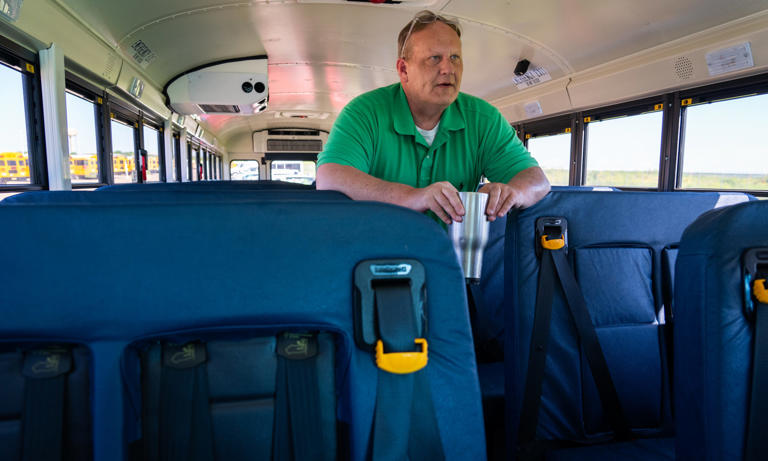
Exclusive: NTSB opens investigation into Hays school bus crash that killed man, boy
The national transportation safety board on monday opened an incident investigation into the hays school district crash on march 22 that killed two, including a prekindergarten student..
The National Transportation Safety Board on Monday opened an incident investigation into a crash last month involving a concrete pump truck and a Hays district school bus carrying 11 adults and 44 prekindergarten students. A student and a motorist driving behind the bus died in the wreck.
The federal agency is investigating the March 22 crash to gain information that could help officials understand similar crashes to determine potential safety improvements, said Kristin Poland, deputy director of Office of Highway Safety at the safety board, in an interview Wednesday. The agency has open investigations into two recent school bus crashes in West Virginia and Illinois.
Unlike a full investigation, the safety board won’t send investigators to the crash site or issue a report or recommendations related to the Hays crash. While she declined to comment on the details of the March 22 crash, Poland said these investigations seek to understand the safety features of the vehicles involved in a crash as well as other factors that could have led to a wreck.
"What we want to understand is what's on the vehicle at the time of the crash and what could have been on the vehicle at the time of the crash," Poland said. "It's not just the school bus. We're looking at all the other vehicles and the environment as well."
The safety board's investigation into the crash — the results of which might be incorporated into pending investigations by the agency into crashes involving school buses in Rushville, Illinois, and in Mount Zion, West Virginia, last month — might shed light on the circumstances leading up to the wreck.
The safety board investigates transportation-related mishaps and practices across the country, making recommendations aimed at improving safety. The board doesn’t have the power to compel government agencies to take action.
The Hays district's bus crash happened about 2 p.m. March 22 on Texas 21 near the intersection with Caldwell Road, while Tom Green Elementary School pre-K students were coming home from a trip to a Bastrop County zoo.
A concrete pump truck, the driver of which was arrested Friday, veered out of its lane and struck the bus traveling in the opposite direction, causing the bus to roll over. The concrete truck also hit a passenger vehicle behind the bus. The crash killed 5-year-old Ulises Rodriguez Montoya, a pre-K student at Tom Green, and 33-year-old Ryan Wallace , who was driving the vehicle behind the bus.
School buses are statistically the safest way for students to travel, Poland said. Seatbelts make school buses even safer, she said.
"Children that are belted that don't have head injuries are able to unbuckle and self-evacuate," Poland said. "They're also in the same location they started in, whether they're upside down or right side up."
Cement pump truck driver an 'imminent hazard to public safety,' federal transit agency says, citing history of drug use
Federal transportation authorities found the driver of the concrete pump truck was an "imminent hazard to public safety" behind the wheel of a commercial vehicle.
The determination comes from the U.S. Department of Transportation's Federal Motor Carrier Safety Administration, which governs the commercial trucking industry. On Friday, in a seven-page order called an "imminent hazard disqualification" form, the federal agency notified the driver, Jerry Hernandez, that he was barred from driving interstate or intrastate commerce.
"This finding means that based upon your present state of unacceptable safety compliance, your operation of any commercial motor vehicle substantially increases the likelihood of serious injury or death if not discontinued immediately," said Brandon A. Poarch, a Federal Motor Carrier Safety Administration field administrator, in the order .
Confirming receipt, Hernandez, 43, signed off on the order at 2:32 p.m. while at St. David's Emergency Center in Bastrop. That same day, Bastrop County authorities arrested him on a warrant charging him with criminally negligent homicide, a state jail felony.
A state jail felony is punishable by a fine of up to $10,000 and jail time of up to two years.
A defense attorney listed in online court records as representing Hernandez did not immediately respond to a request for comment.
In September 2020, Hernandez refused a "required reasonable suspicion" test for controlled substances after telling his employer at the time he had recently used illegal drugs and would test positive, according to the notice. He subsequently sought treatment from a substance abuse professional.
In December 2022, Hernandez tested positive for marijuana use after the substance abuse professional, the same one from nearly two years prior, ordered a follow-up test, according to the notice. He again sought treatment.
In April 2023, Hernandez tested positive for cocaine in another follow-up test ordered by the professional. He sought treatment again but "failed to complete any treatment plan" as required by federal law, according to the notice.
"Your blatant violations of the (Federal Motor Carrier Safety Regulations) and disregard for the safety of the motoring public demonstrated by these actions substantially increases the likelihood of serious injury or death to you and the motoring public," Poarch said in the order.
Despite violations, truck driver listed as 'eligible' in Texas license system
As a result of the alleged drug offenses, Hernandez had a "prohibited" status on his commercial driver's license, banning him from driving interstate commerce. However, a search of the Texas driver's license system showed he was "eligible," a Texas Department of Public Safety trooper wrote in charging documents for Hernandez, meaning he was permitted to drive so long as he remained in the state.
Federal reporting requirements around drug and alcohol violations of drivers with commercial driver's licenses and what triggers ineligibility might change in November. Had those changes been in effect, Hernandez's commercial license would have been downgraded, barring him from driving a pump truck for the purpose of intrastate commerce, the trooper wrote.
Spokespeople for the Federal Motor Carrier Safety Administration did not immediately provide comment. Spokespeople for the Texas Department of Public Safety, which handles the state licensing system, did not respond to a request for comment Wednesday morning.
Francisco Martinez Jr., the owner of FJM Concrete Pumping LLC, which owned the concrete pump truck, told investigators he did not verify the status of Hernandez's commercial license or his driver's history prior to employing him, according to the charging documents for Hernandez.
On Tuesday, Martinez pleaded no contest to employing an unlicensed driver — not Hernandez, records show — and paid the $316 ticket, closing the October 2021 case. On Monday, Hays County Precinct 4 Justice of the Peace John Burns issued a warrant after Martinez failed to pay the years-old delinquent fine.
Federal reporting requirements regarding driver violations might be a subject of the safety board's investigation and ultimate recommendation, should the agency issue one.
The safety board examines "all aspects" of the circumstances surrounding similar wrecks, including the handling of past violations for involved drivers, Poland said.
Such was the case when the safety board investigated a June 2019 crash involving a truck towing a vehicle-hauling trailer that collided with a group of motorcycle riders in Randolph, New Hampshire, killing seven riders and injuring seven others. The at-fault truck driver was impaired by several drugs and had a suspended license in Connecticut, but "deficiencies in out-of-state driver's license notification processing" resulted in the Massachusetts Registry of Motor Vehicles failing to revoke his license.
At the end of that investigation, the safety board recommended improvements to the "processing of interstate licensing notifications and federal oversight of motor carriers."

IMAGES
VIDEO
COMMENTS
JEJU, South Korea — The promises came too late for the overloaded South Korean ferry, too late for the 250 students who drowned when it capsized on a school trip to a resort island.
Lee Ho-jin died eight years ago at the age of 16, one of 250 sophomore students whose lives were taken when the Sewol ferry sank off the southwestern coast of South Korea on April 16, 2014. More ...
The ferry MV Sewol sank on the morning of April 16, 2014, en route from Incheon towards Jeju in South Korea. The 6,825-ton vessel sent a distress signal from about 2.7 kilometres (1.7 mi; 1.5 nmi) north of Byeongpungdo at 08:58 KST (23:58 UTC, April 15, 2014). Out of 476 passengers and crew, 304 died in the disaster, including around 250 students from Danwon High School in Ansan City.
Survivors of South Korea's Sewol ferry disaster have begun testifying against the captain and crew. The passenger ferry capsized on 16 April, killing 304 of the 476 people on board. More than 300 ...
At least 294 people died when the Sewol ferry capsized off South Korea's coast on April 16. Many of the victims were high school students from the town of Ansan on a field trip
The ferry, the 6,825-ton Sewol, capsized and sank off the southwestern tip of South Korea on April 16, 2014. The accident was the country's worst catastrophe in decades, and it contributed to ...
By Jungmin Jang and Ju-min Park MOKPO/JINDO, South Korea (Reuters) - The vice-principal of a South Korean high school who accompanied hundreds of pupils on a ferry that capsized has committed suicide, police said on Friday, as hopes faded of finding any of the 274 missing alive. The Sewol, carrying 476 passengers and crew, capsized on Wednesday on a journey from the port of Incheon to the ...
Like so many other students, they went on a school trip to Jeju Island, the most beautiful place in South Korea, in the blue spring of April. They failed to return home. The sunken ferry was not ...
Jung Hye-suk, mother of Park Sung-ho, a high school student who died in the Sewol ferry disaster, poses for a photograph in her son's room, as well as details of objects, in Ansan April 7, 2015.
The sunken Sewol ferry is raised during its salvage operations at the sea off Jindo, South Korea on March 23, 2017. News1 via Reuters. SEOUL, South Korea — A 6,800-ton South Korean ferry emerged ...
Jan 19, 2016, 04:06 PM. SEOUL (AFP) - Heart-wrenching messages of fear, love and despair, sent by high-school students from a sinking South Korean ferry, added extra emotional weight Thursday to a ...
The first of 75 school children to speak in the trial over the South Korean ferry disaster have described how they were forced to float to safety after coastguard officers refused to help them and ...
In mid-June, South Korea began operations to raise the ferry , which sank with 304 people on board, including 250 children who were on a school trip. Nine bodies are still missing .
The Sewol ferry was found by government investigators to be structurally unsound and overloaded when it capsized in April 2014, killing 304 people including 250 children who were on a school trip.
Deadly ferry accident off South Korea 18 photos There were 475 people aboard - many of them high school students on a class trip - and frantic parents have gathered at their school near Seoul and ...
Of the 476 people who were on board the ferry when it sank, 323 of them were second-year Danwon students on a class trip. Only 75 students were rescued — 245 died and five are still missing ...
The Sewol ferry, bound for Jeju Island in South Korea, began to sink. On board were 476 passengers, including 325 students on a school trip. Mobile phone footage records students struggling to ...
Most of the passengers, according to news reports, were high school students and teachers on a school trip. ... NPR's Anthony Kuhn reports about the ferry accident. Listen · 3:13 3:13.
The pupils and their teachers, from Danwon high school in the Seoul suburb of Ansan, were travelling to Jeju island for a four-day study trip, along with about 150 other passengers, when the ...
Hundreds missing after ferry disaster off South Korea 02:23. MOKPO, South Korea --A ferry carrying 462 people, mostly high school students on an overnight trip to a tourist island, sank off South ...
The Sewol ferry was found by government investigators to be structurally unsound and overloaded when it capsized in April 2014, killing 304 people including 250 children who were on a school trip.
A year ago this week, the accident claimed the lives of more than 300 passengers, most of them teenagers on a school trip to Jeju. Image Kim Chul-soo, the captain of the Sea Star Cruise.
Official MapQuest website, find driving directions, maps, live traffic updates and road conditions. Find nearby businesses, restaurants and hotels. Explore!
According to TEA data, fatal school bus crashes are rare in Texas. Between 2009 and 2023, seven children and two adults have died in crashes involving school buses. Over that same time period, 98 ...
The Hays district's bus crash happened about 2 p.m. March 22 on Texas 21 near the intersection with Caldwell Road, while Tom Green Elementary School pre-K students were coming home from a trip to ...